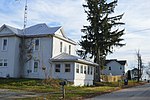List of Indiana state historical markers in Randolph County
Geographic coordinate listsIndiana state historical markersLists of coordinatesTourist attractions in Randolph County, Indiana

This is a list of the Indiana state historical markers in Randolph County. This is intended to be a complete list of the official state historical markers placed in Randolph County, Indiana, United States by the Indiana Historical Bureau. The locations of the historical markers and their latitude and longitude coordinates are included below when available, along with their names, years of placement, and topics as recorded by the Historical Bureau. There are 2 historical markers located in Randolph County.
Excerpt from the Wikipedia article List of Indiana state historical markers in Randolph County (License: CC BY-SA 3.0, Authors, Images).List of Indiana state historical markers in Randolph County
East 600 S,
Geographical coordinates (GPS) Address Nearby Places Show on map
Geographical coordinates (GPS)
| Latitude | Longitude |
|---|---|
| N 40.077222222222 ° | E -84.816388888889 ° |
Address
East 600 S 8619
47390
Indiana, United States
Open on Google Maps




